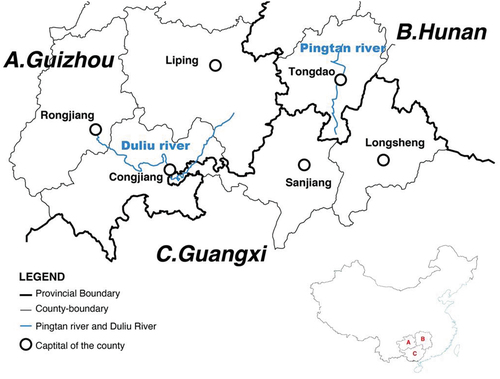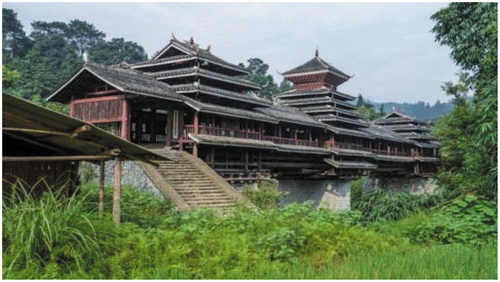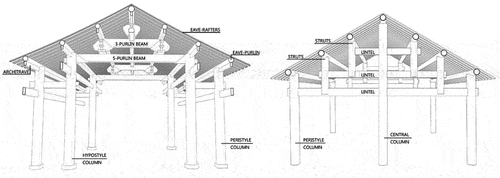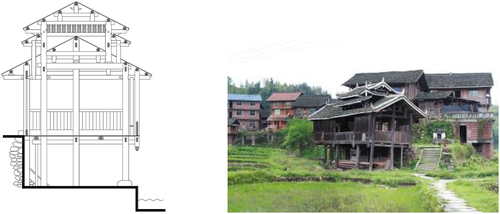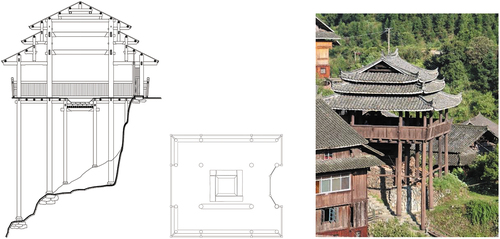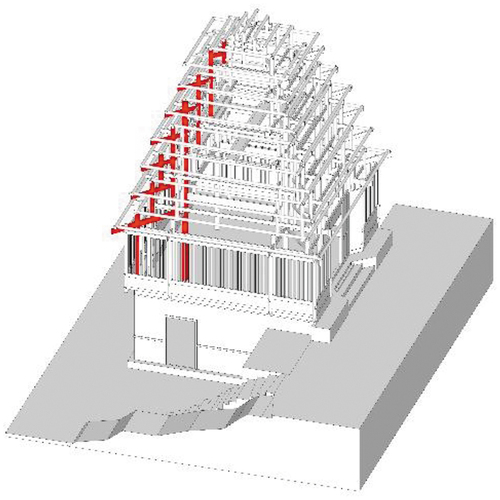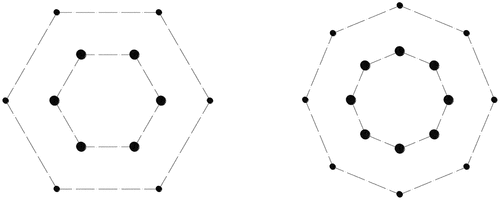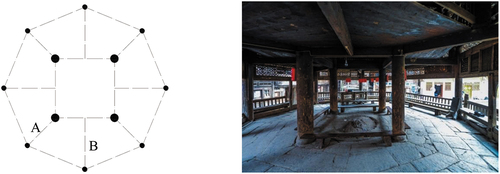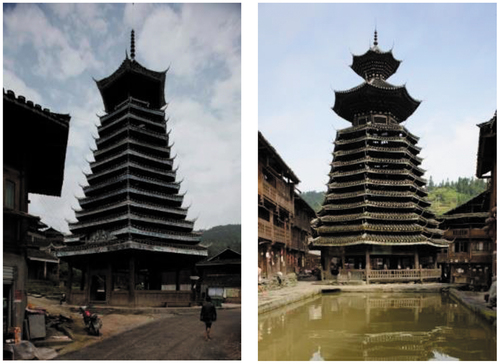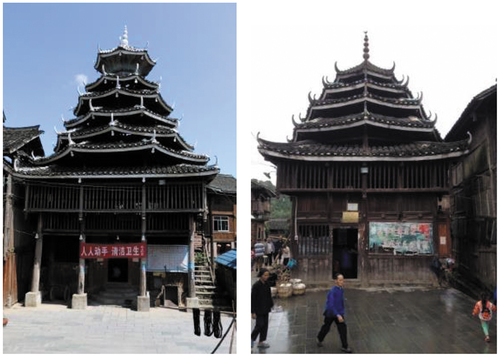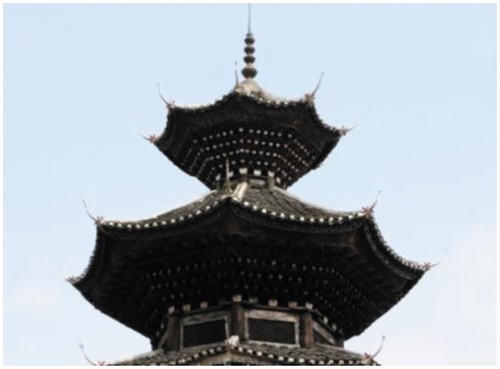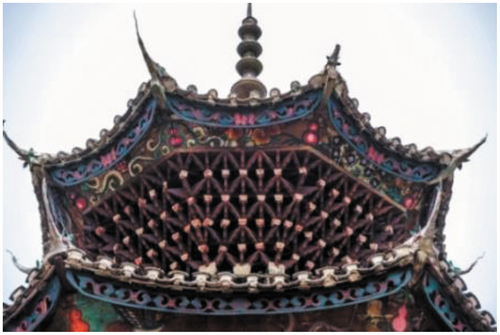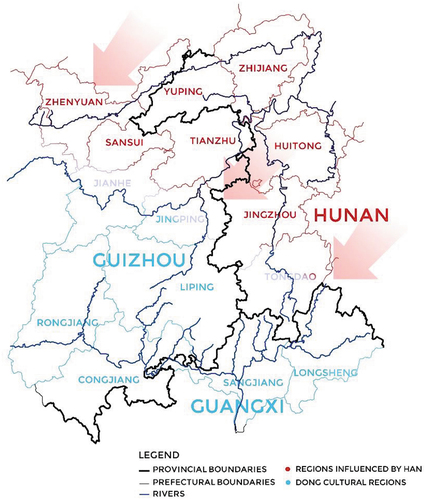ABSTRACT
The Pingtan river basin in Hunan and the Jiudong area in Guizhou are two typical Dong minority settlements in the southern Dong area. However, an evident difference reveals during the field survey from a global (village level) and local (architecture level)view. This paper conducts a comparison study between these two regions, ranging from the architectural composition of the villages, and the construction techniques of Drum Towers to the façade configuration of Drum Towers. Finally, this paper aims to unveil the main cause behind the differentiation, exploring the proximity to Han concentration and interlinks between these two regions.
1. Introduction
The Dong ethnic minority people are one of China’s 56 ethnic groups and live in the region delimited by southwest Hunan, southeast Guizhou, and north Guangxi. Tongdao County of Hunan,Sanjiang County of Guangxi, Liping County, Congjiang County, and Rongjiang County of Guizhou are the primary Dong settlements in which the population of Dong people makes up more than 70%. As one of the minorities in southern China, Dong has been widely regarded by the Han as Nan-man (南蛮, southern barbarians). Historically, there has always been this paradoxical consciousness among the Han about non-Han people on their frontiers (Ruan Citation2006). The Han, by contrast, being the majority, are known to have self-assured ethnocentrism, not only against the background of minorities within China, but also the rest of the world: “China,” literally means the “Middle Kingdom”. The Dong territory is highly inaccessible, which suggests that until the 18th century the Han Chinese were not truly able to take the upper hand over the minorities who had settled there. Dong people have gone through a self-created ethnic culture, the influence of different ethnic cultures and cultural collisions, transformations and fusions from its settlement. The proximity of the Dong area to the Han concentration, and also the different areas within the Dong settlements reveal the regional characteristics of architecture form and structure. The Pingtan river basin and Jiudong area are the typical Dong settlements that represent the connection and differentiation between Dong settlements and Han concentrations.
Among the traditional Dong settlements, Chuan-dou(穿斗式,a column-tie typology) and Tai-liang(抬梁式,a post-beam typology) serve as the two main structural typologies in Dong traditional construction(Cai Citation2007). Chuan-dou Drum Tower applies dense multi-eave roof, which creates a pyramidal morphology, while Tai-liang resembles to the Han main hall. During the field survey, Tai-liang mainly dominated in the Pingtan river basin and Chuan-dou dominated in the Pingtan river basin and Jiudong area. However, the architectural form of Chuan-dou in the Pingtan river basin is different from that in the Jiudong area.
Both the Pingtan river basin and Jiudong area have the same hierarchy of “sub-kuan” (款,the original social organization within Dong villages). Kuan is indicated by the same or similar geographical space. The divisions of rivers and water areas are important geographical indications. With nine sub-kuans, Tongdao County was organized according to the division of rivers and water areas in the period from the late Qing Dynasty until the 20th century. Similarly, the Jiudong area is located along the Duliu river coast in Congjiang County of Guizhou and consists of sub-kuan divided by rivers and water areas.
Both the Pingtan river basin and Jiudong area were included in the World Cultural Heritage Tentative ListFootnote1
Both Pingtan river basin and Jiudong area are located along the river coast in a linear distribution. Dong villages in the Jiudong area along the Duliu river and Pingtan river basin are similar, and are connected by a linear water area, which constitutes the Dong cultural corridor ().
Hence, social organization and geographic relations determine the proximity of the Pingtan river basin and Jiudong area. However, a large difference exists between the two areas with respect to the architectural form and structural typology. To unveil the underlying causes, Dong villages and the architecture of the Pingtan river basin and Jiudong area are selected as the case study.
2. Literature review
Affected by its own political, economic, and cultural changes, the Han nationality’s cognition of the Dong minority and its ancestors showed phased characteristics. The ancestors of the Dong minority in the Qin Dynasty were called “Yunzhong-man”(駖中蛮), and the Han Dynasty called them “Wuling-man”(武陵蛮) and “Wuxi-man”(武溪蛮) was called “Liao”(僚) in the Wei, Jin, Southern and Northern Dynasties, and the names “Liao Hu”(僚浒)and “Wu Hu”(乌浒) appeared in the Tang Dynasty. These titles are collective names for the ethnic groups living in the corresponding areas, and the ancestors of other ethnic groups such as Miao(苗) and Yao(瑶) are also included. The “Geling”(仡伶)Footnote2 found in Song Dynasty literature is generally considered to be the self-proclaimed name of the ancestor of the Dong minorityFootnote3
“Dong” (峒)was a type of social administrative organization in the Tang and Song Dynasties. At that time, the term “Dong-min”(峒民) Dong-man“(峒蛮) referred to all ethnic groups under this administrative organization. “Dong-miao”(峒苗), “Dong-man”(峒蛮), “Dong-jia”(峒家)Footnote4found in Qing dynasty literature as a greater relevance to the Dong people today, but at the same time, there are still multiple names for the Dong people as “Miao”(苗) and “Man”(蛮)(Yao and Shi Citation2005). The names of the Dong people and their ancestors include general references to other ethnic groups. To a more specific reference, it reflects the continuous deepening of the Han nationality’s cognition of the Dong minority. At the same time, it also reflects the historical situation of the integration of the Han and Dong cultures. The difference in the degree of influence of the Han culture has led to the emergence of two settlements of the Dong minority. The prevailing view of the large dialect area, sociology and ethnology believe that a significant cultural shift has occurred in the northern dialect area, and its customs and beliefs have strong Han cultural characteristics, while the original culture of the Dong ethnic group remains relatively intact in the southern dialect area (Liao Citation2007). The emergence of cultural differences is reflected in the settlements and architectural forms, the most obvious of which is that the Drum Tower, the iconic building of the Dong minority, only appears in the Southern Dong area today, while it is difficult to find in the Northern Dong area and other Zhuang-Dong-speaking ethnic groups. The centripetal settlement pattern surrounding the Drum Tower is also a unique pattern of the Southern Dong settlement.
Concerning the study of Southern and Northern Dong. Hu Bizhu analysed the materials and construction techniques of Drum Tower in Hunan region (Hu Citation2012), while Li Miao takes the traditional architectural features in Tongdao county, Hunan as research aim, narrating from the perspective of conservation and inheritance of architectural traditions, Li develops some innovative strategies for economic development and renovation suggestion on improving dwelling facilities based on the social and economic problems in Dong community (Li Citation2011). Xiao Hua presents a comparison study, showing that due to the cultural influence of Han nationality, the Northern and Southern Dong areas develop a diversity of village layouts and architectural features (Xiao Citation2011). Previous contributions concluded how the proximity to Han concentration influenced architecture styles and forms, and how the two Dong regions are connected in history in Dong settlement and culture.
Previous contributions reveal grand narrative features in the study of Dong architecture, which presupposes that “Dong architecture has its minority style. The “style” view, which regards the more common architectural forms in a certain area (usually a province or a district of the Dong ethnic group) as a common feature of the Dong minority’s architecture in the area, and the history of the Dong minority’s architecture is now presented as a simplified static history, while the diversity of architectural forms and the dissemination of architectural culture have been neglected. In recent years, the research on Dong architecture has been dominated by case studies. These studies have supplemented and revised the grand narratives of the past to a certain extent, but the case studies also have the defect of only seeing the trees but not the forest (Ju Citation2021). It is unable to notice the relationship between the architectural forms of the different areas of the Dong settlements, the influence of different ethnic interactions and the spread of Han culture on the Dong architecture. Therefore, it is unable to reveal the emergence and evolution of the Dong architectural forms. Therefore, to advance the understanding of Dong architecture, a non-grand narrative macroscopic perspective is needed. The study of terroir and architectural genealogy can provide such a perspective to compensate for the deficiencies of existing research.
3. Methodology
Ethnography as a text has evolved from being amateurish, spontaneous, and often based on imagination and hearsay writing to a scientific record based on fieldwork(Wang Citation2015). In the modern sense, ethnography not only records the cultural phenomenon of a particular social community, but also includes the overall and systematic theoretical explanation of the phenomenon. Therefore, ethnography is not only a writing text, but also an anthropological research method. Modern scientific ethnography methods are mainly derived from anthropology. Malinowski, the founder of anthropology in the 20th century, advocated that through personal environmental experience and field investigations, he should use the eyes of the other and change his position as the main position to explore traditional settlements. The social composition and operational function of the French anthropologist Levi Strauss proposed a structural anthropological method of cognitive representation through the deep structure of the social organization structure and the subconscious spatial identity schema (Chang Citation2008).
Field surveys include observations of phenomena in the category of ethnography, documentation of oral history, and surveying and mapping and image recording of buildings, settlements, and natural settings, including an in-situ sketch of the frame structure, carpentry works, obtainable technical drawings, such as AutoCAD, 3D models, and photographs or other pictorial data. There are few specific records about the Dong minority’s terroir and architecture in the historical documents, but there are various directly related memories that survive in the present. Therefore, the documentation of oral history is an important content of fieldwork in this paper.
4. Architectural composition of Dong villages
4.1. Public buildings
Through field survey, the typology and number of public buildings can be compared and summarized as follows (),
In addition to the public buildings normally located in traditional Dong villages in the Pingtan river Basin (such as The Drum Tower, Wind-rain Bridge, Sa-Altar and the Feishan Palace), there are also a large number of traditional Han architectural relics such as The Nanyue Temple, The Town God’s Temple, The Temple of the Society of God, The Yunxia Temple and other abundant public buildings. They indicate that this region is deeply influenced by the culture of Han nationality as well as a mixture of Han and Dong cultures. However in the villages of the Jiudong area, in addition to The Drum Tower, Wind-Rain Bridge and Sa-Altar, few public buildings contain both characteristics of Han nationality and Dong minority characteristics.
The Drum Towers in the Pingtan river basin have a long history, with ten of them having been constructed in the late Qing Dynasty. Drum Towers in the Jiudong area were mainly built during the early 20th century.
Table 1. Composition of public buildings in two regions.
Dong villages in the Pingtan river Basin are located along the river, which is the reason for the construction of the Wind-Rain Bridge. An overall survey of Dong villages in the two regions revealed that the Dong minority settlements in the Guizhou Jiudong area are not distributed along the two sides of the river as in The Pingtan river Basin. The only large-scale Wind-Rain Bridge in Diping Town, Liping County, namely Diping Wind-Rain Bridge, spans the Nanjiang river (). There are small brooks through the villages and therefore no single river hosts Wind-Rain bridges.
Compared with the situation in Guizhou Jiudong, the Wind-Rain Bridges in the Pingtan river basin have the following characteristics:
A large number of cultural relics and a high protection level. The nine bridges in the Pingtan river basin are cultural and historical sites, protected at the national level. The three bridges in Yutou villages are an important part of “Yutou Dong Village’s Ancient Buildings” and are also historical and protected sites.
A variety of types of bridge structures in the Jiudong area. There are no slanting cantilevered bridges such as the Puji bridge and Huilong bridge in Pingtang village. Its bridge structure is not arched.
The Huilong bridge in Tongdao County is the only Dong Wind-Rain bridge with an arch-shaped bridge house.
4.2. Residential Buildings
As stilt dwellings are the main residential buildings in Dong settlements, they were used as a typical objective in the comparison study of Dong residential buildings in the Guizhou Jiudong and Pingtan river basin.
According to various functions and importance of indoor space of a stilt dwelling, the house is divided into four parts: ritual space, living space, auxiliary space and circulation space. Ritual space includes fireplaces and central rooms, playing an important spiritual role in indoor layouts. Living space includes front porch, bedrooms, etc., serving as a place for daily life. Auxiliary space includes livestock sheds, storage rooms and bathrooms, used for daily production and living. Circulation space mainly refers to the wooden ladder, the vertical circulation dominating the get in and out of the privacy space – living space. The functional elements of the residential plane are mainly composed of these four types of space, and stilt dwellings of Dong villages in the Pingtan river basin and Jiudong area basically have the same space elements. However, the main living space, that is the second floor, is much different in space sequence and layout. There are three main types of plane layouts for the living space, named front porch connecting to living space, front porch connecting to the fireplace, and front porch connecting to the central room ().
Figure 3. Plane layout of stilt dwellings (from left to right: front porch connected to living space; front porch connected to fireplace; front porch connecting to central room).

Each type of house reflects the different ethnic characteristics and the way foreign cultures are integrated. If placed in the geographical space of Pingtan river basin and Jiudong area, and considering their geographical locations, they can better reflect the interrelation of the differences in spatial distribution and geographical location of the two regions. The residential types of the two regions have the following regional distribution pattern:
Dong villages in Jiudong mainly adopt layouts of front porch connected to living space and front porch connected to fireplaces. Because fireplaces have a vital position in residential buildings, the residential buildings in this area can be regarded as preserving a more primitive and traditional way of living.
5. Construction technique of Drum Towers
The construction technique of Drum Tower can be divided into two structural typologies: Tai-liang and Chuan-dou. The difference between these two typologies is specifically the beams or lintels between the two columns (). The former was generally built much earlier, mostly in Qing Dynasty, with a multi-eave gable and hip roof or combination of village gate; the main structure and shape of Drum Tower are similar to the wooden hall-style building adopted by Han Chinese in the south part of China; the latter one, built a little late, are buildings of Qing Dynasty to the contemporary era, and most are towering Drum Towers with a multi-eave and pyramidal roof.
Tai-liang typology, there is a tie-beam between two peristyle columns, or two hypostyle columns, on which two struts support the 3 or 5 purlin beams. The purlins – horizontal members that support the rafters – are positioned along the stepped shoulders of the skeleton. Tai-liang can form a wider space between the two peristyle columns or two hypostyle columns, which depends on the length of the tie-beam (Cai and Ferretto, Citation2016). These kinds of Drum Towers often have some common characteristics: the first, by having a rectangular shape; the second, by having roof styles that often include an overhanging gable roof and a gable-and-hip roof, or even a composite roof style, like Xiaozhai Drum Tower (). Sometimes, large columns are used to support the ground floor of the Drum Tower to adapt to any distinctive topography (). The structure and modeling of the Tai-liang Drum Tower is simple and clear, which is resemble the main hall of Han nationality buildings. It is often combined with other kinds of buildings such as the village gates, Han temples, and auxiliary buildings, such as Yanglan Drum Tower (), thus forming a complex with special shapes along with a variable public space within the villages.
According to the field survey, Dong villages in Guizhou Jiudong area basically do not have Tai-liang Drum Tower. It only has Chuan-dou Drum Tower, and all such Drum Towers apply towering multi-eave and pyramidal roof Drum Tower. In structural technology, Drum Towers in both regions adopt the most basic type of “ring column” pattern, with inside and outside column networks uniform in shape; that is, hypostyle columns form the same geometric figure shape as that of outer eave pillars, and there is no roof structure transformation. This structure is simple and concise, that is, the hypostyle column and outer eave pillar are horizontally jointed by penetrating ties, which support struts and overhangs layer by layer, and finally cornice penetrating ties are used to connect the strut and hypostyle column. This structure is repeatedly upwards and becomes narrow. The struts between the hypostyle column and outer eave pillar are connected to the suspended column by a diagonal penetrating tie, forming a roof truss. This roof frame is the basic unit of Drum Tower of this type, each a diagonal between hypostyle column, and outer eave pillar adopts this basic unit repeatably (). Most Drum Towers in the Pingtan river basin adopt the variant of the “ring column” pattern - “increase strut”, which changes the roof structure, and thus forms multiple facades. This is the largest construction technical difference between Drum Towers in the Pingtan river basin and Jiudong area.
“Increase struts”, the common technical measure that has been adopted on Drum Tower in the Pingtan river basin is to increase the number of supporting struts. That is, the upper roof of the Drum Tower transforms from a lower quadrangular hipped roof into an octagonal or a hexagonal pyramidal roof by using the four inside columns to form an octagonal or a hexagonal plane, with increased struts and the lintels. The methods for increasing the number of columns are diversified ().
According to the study, there are two types of column network of “ring column” patterns in Jiudong area: forming a hexagon both inside and outside, and forming an octagon both inside and outside ().
The construction techniques of Drum Towers in both the Jiudong area and Pingtan river basin are summarized below (). The table clearly shows the different construction techniques applied by the two regions.
Table 2. Comparison of the Chuan-dou techniques.
The Drum Tower in the Jiudong area mainly adopts the column network of forming a hexagon both inside and outside, such as Chaoli Drum Tower in Chaoli village. The six columns inside and outside form two hexagonal rings, with the inner hypostyle column and the outer eave pillar horizontally connected by penetrating tie, which supports the strut, forming a roof truss; such roof truss is to be set up repeatedly.
To meet the needs of different use spaces and the requirements of external façades, another structure emerged in the Jiudong area, that is, “lessen struts”, which is not seen in the Pingtan river Basin.
The method of lessening the strut is to subtract four hypostyle columns from the original eight hypostyle columns, making the inner column network a square, while the outer column network is still an octagon. For example, the Zengchong Drum Tower of Zengchong village, Congjiang County (), and Zaidang Drum Tower of Zaidang village, Rongjiang County (). For the roof frame without hypostyle column (A), the cornice penetrating tie posts on the midpoint of the ring beam between hypostyle columns. The other roof frame (B) is set up similarly to the hexagonal “ring column” structure, with the hypostyle column and outer eave pillar connected by a penetrating tie. The layout for struts of roof trusses A and B is the same. This structure causes a large shearing force to the mid-point of the ring beam between hypostyle columns, so the cross-sectional area of the ring beam is generally thicker.
6. Façade configuration of Drum Towers
The façade configurations of Drum Towers in the Jiudong area are simpler than those in the Pingtan river basin. The primary typology is the tower-like and individual Drum Tower, and there is no other composited type, which is similar to an auxiliary village gate or roof type.
The Drum Towers in Jiudong area are more towering and higher than in Pingtan river basin, which the minimum is seven-storey, and the maximum is thirteen-storey, there are in total 4 Drum Towers which have thirteen-storey, like Chaoli Drum Tower, Zengchong Drum Tower (). On the other hand, the Drum Towers in the Pingtan river basin are no more than nine stories, there are only two Drum Towers have nine stories, which are generally five or seven stories ().
For the roof style, the pyramid roofs are dominated in the Jiudong area, yet there are not only pyramid roofs but also gable and hip roofs in the Pingtan river basin, which tend to be more diversified in the roof style.
There is a distinctive and regional joint-work, “neck of tower” and “honeycomb”. With the roof structure upwards and narrowing to the top, the cornice is uplifting and overhanging, that is, the “neck of tower” (), moreover, the overhanging Tou-kung layer is called “honeycomb” (). Almost all the Drum Towers in the Jiudong area adopted these joint works. However, few cases in Pingtan river basin adopt this sort of structure.
For the decoration on the ridges, cornices, neck of towers, top roofs, etc. adopt a more delicate and distinctive decoration work, that is, sculpture, and painting. They embody a higher aesthetic significance than that in the Pingtan river basin, which tends to be more simplified.
7. Transmutation: transmission of the Han culture
The diversity of culture within the architecture is closely connected with the difference of the social culture in various geographic spaces.
The governance and time period in which the central dynasties governed the Dong regions are significantly different. It is important to explain the cultural differences in the Dong minority’s habitation regions. The development of border areas by the central government stretched from the northeast Dong residential areas to the southwest hinterland. The northern area of the Dong minority’s habitation regions has been included in the jurisdiction and scope of the central government as early as the Tang dynasty. For counties such as Liping, Rongjiang and Congjiang inhabited by the Dong minority in Guizhou, the system of the central government appointing officials for direct management has been implemented since the Song dynasty and was truly established during the Qing Emperor Yongzheng’s reign.
The development of border areas directly caused the influx of a large number of Han nationality immigrants. The Han went into the Dong minority’s habitation regions by acting as officials, defending soldiers and by spontaneous immigration. The most prosperous period for immigration was during the Ming and Qing dynasties. The army and the people going into the Dong minority’s habitation regions for cultivation were mostly the Han from Jiangxi and Hunan provinces. The immigration direction from the east to the west has helped to determine the direction of cultural transmission of the Han. Therefore, immigration during the Ming and Qing dynasties is a vital cause for distinguishing the east-west architectural culture in the Dong minority’s habitation regions ().
In the Dong minority habitation regions of the Hunan and Guizhou provinces, Hunan is closer to the habitation regions of the Han from a geographic perspective and the Tai-liang is therefore affected by the hall-type buildings of the adjacent Southern Han nationality. Accordingly, the Chuan-dou Drum Towers appear mainly in Guizhou, which is relatively more remote. Because of this, the more native structural techniques of the minority are maintained in this area.
8. Discussion and conclusion
Compared with Jiudong area, the types of public buildings in Pingtan river basin are more abundant, not only the Drum Tower, Wind-Rain Bridge, Sa-Altar, and Feishan Palace normally seen in traditional Dong villages as Jiudong area, but also exists a large number of traditional Han architectural relics. For the dwellings, the type “front porch connecting to central room” is mostly located in the Pingtan river basin, and the type “front porch connecting to living space” and “front porch connecting to fireplace” are adopted in the Jiudong area, which embodies the difference in Han culture influx between the Pingtan river basin and Jiudong area. There are no Tai-liang Drum Towers in the Jiudong area, but the Chuan-dou typology. Moreover, the method of changing the roof structure is less adopted in Jiudong area’s Drum Tower, which is the largest difference between these two regions. For the façade configuration, the Drum Tower in the Jiudong area is higher and more towering than in the Pingtan river basin, and the decoration tends to be more delicate and colorful. Tai-liang Drum Towers affected by the Han building are concentrated in the eastern Dong area (Hunan Province), while the Chuan-dou Drum Towers are mainly distributed in the western Dong area (Guizhou Province). In the process of the development of cultural dissemination from the northeast Dong residential areas to the southwest hinterland, the number of Tai-liang Drum Towers decreased but the Chuan-dou ones were replaced.
Since the Ming Dynasty, Han immigrants from both the governmental and non-governmental sectors have been stationed in the Southern Dong area and become an important part of human ecology. Some Han immigrants have their own independent living space and maintain the identity of the Han nationality. The Han population in Dong area has undergone the “Dongization” of identity, which has a subtle influence on the traditional culture of the Dong. In addition, new cultural factors have been added to the life form of the Dong people, and the settlement morphology and architectural forms have also changed accordingly. By comparing the differences in existing settlements and architectures, it is possible to explore how cultural transmission acts on architecture. The influence of Han culture has made Dong culture more complicated, but we cannot simply think that the evolution of architectural forms is a parallel process of complexity. In fact, because Han culture has eliminated some of the traditional meaning of architectural forms instead, their forms tend to be simplified. Therefore, this paper uses the Jiudong area and the Pingtan river Basin as entry points to deepen the study of the continuation and evolution of the Dong architectural culture.
Data source
All figures and photographs are drawn and shot by author, Ling Cai, Xiaotie Chen, etc. through massive in-situ survey from 2015–2018.
Acknowledgements
This research was funded by “National Key R&D Program of China(grant number: 2021YFE0200100)”, “China Postdoctoral Science Foundation (grant number: 2021M692352)” and 2021 Policy Directed Program of Jiangsu Province (BZ2021015). The early draft of this article was presented at International Congress on Architecture and Landscape in the ethnic minority territories (2018) and included in the conference proceedings. I would like to express my gratitude to Prof. Ling Cai and Prof. Francesco Augelli for their valuable supporting and comments for this research. Author intends to acknowledge local authorities who offered a great support. Special acknowledgement to the skilled local carpenters and warm villagers.
Disclosure statement
No potential conflict of interest was reported by the author(s).
Additional information
Funding
Notes
1 On December 15th 2006, the State Administration of Cultural Heritage in China published and submitted 35 cultural heritage examples to UNESCO World Cultural Heritage Center. The Dong villages in QianDong-nan(southeast of Guizhou Province) has been listed NO.29. “Liudong” area includes Tang’an village, Jilun village, Jitang village, Dengkang village, Xiage village and Zhaoxing village of Liping county. The Jiudong area includes Zengchong village, Yintan village, Zeli village, Gaoxian village, Xindi village of Congjiang county; and Dali village, Zaidang village of Rongjiang county; Dengceng village and Shudong village of Liping county. In Jiudong area, Zengchong village, Yintan village, Zeli village, Gaoxian village of Congjiang county; Dali village, Zaidang village of Rongjiang county has been officially included in World Cultural Tentative Heritage List on January 29th 2013..
2 Referred to the literatures in Song dynasty “A Categorical Narration of the Region Beyond the Passes”(1187).
3 Referred to “Tongdao Dong Minority Annal” revised in 1999..
4 Referred to the literatures in Qing Dynasty as “Book of Guizhou”(1690), “A Handbook of Guizhou” (1700s), “Brief Records of Dong in the Chu Kingdom” (1700s). “Recording of Guizhou” (1813).
References
- Cai, L. 2007. Traditional Villages and Architecture of Dong Nationality’s Habitation Region. China: China Architecture & Building Press.
- Cai, L., and P. Ferretto, 2016. “A Study of Timber Structure of Drum Towers of Chinese Dong Minority Architecture and Its Development Evolution”. 2016 IIWC Conference and Symposium: 51–61.
- Chang, Q. 2008. “The Anthropological Perspective of Architecture.” Architect, China, no. 6: 95–101.
- Hu, B. 2012. Hunan Drum Tower Construction Technology. China: Master dissertation of Hunan University.
- Ju, K. 2021. Study on the Pedigree of Southern Dong Vernacular Architecture. China: Southeast University Press.
- Li, M. 2011. Research on the Conservation and Inheritance of Tongdao Dong Village and Architecture. China: Master dissertation of Hunan University.
- Liao. 2007. Traditional Cultural Characteristics of Southern Dong Minority. China: Nationalities Publishing House.
- Ruan, X. 2006. Allegorical Architecture: Living Myth and Architectonics in Southern China. USA: Honolulu University of Hawaiʻi Press.
- Wang, M. 2015. “Ethnography: A Re-Definition from the Perspective of the Extended Human Relations”.” Academic Monthly, China 47 (3): 129–140.
- Xiao, H. 2011. A Comparison Study on the Villages Morphology of Northern Dong and Southern Dong in the Southwest of Hunan. China: Master dissertation of Hunan University.
- Yao, L., and K. Shi. 2005. Social Changes in the Dong Nationality Region. China: Minzu University of China Press.

